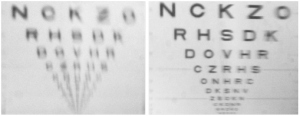Abstract
Current intraocular lenses (IOLs) are designed to substitute the cataractous crystalline lens, optimizing focus at the fovea. However, the common biconvex design overlooks off-axis performance, leading to a reduced optical quality in the periphery of the retina in pseudophakic patients compared to the normal phakic eye. In this work, we designed an IOL to provide better peripheral optical quality, closer in that respect to the natural lens, using ray-tracing simulations in eye models. The resulting design was a concave-convex inverted meniscus IOL with aspheric surfaces. The curvature radius of the posterior surface was smaller than that of the anterior surface by a factor that depended on the IOL power. The lenses were manufactured and evaluated in a custom-built artificial eye. Images of a point source and of extended targets were directly recorded at various field angles with both standard and the new IOLs. This type of IOL produces superior image quality in the whole visual field, being a better surrogate for the crystalline lens than the commonly used thin biconvex intraocular lenses.
© 2023 Optica Publishing Group


